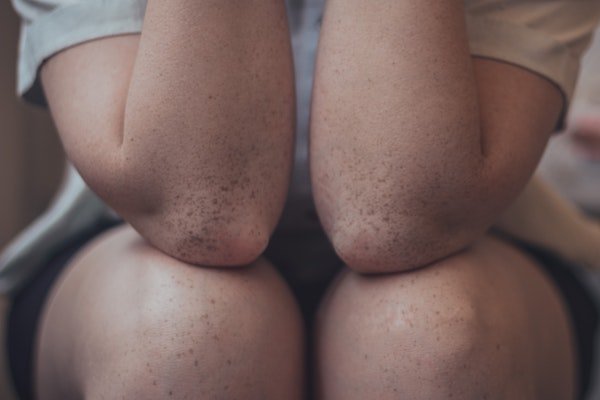Suffering from bad knees during a workout is truly bothering and totally demotivating. Especially when you’re suffering from chronic knee pain; it would affect even the simplest movements. I for one have suffered from knee pain as well, however my issue was that my quadricep muscles weren’t strong enough when I first started out – but more on that later.
If you’re experiencing some knee pain from just doing basic chores, what more if you’re performing some daily exercise?
Doing exercises that can trigger more pain for your bad knees must be avoided most especially when these cause immense discomfort. Of course, there are different causes of knee pain and one of them is arthritis or an injury.
For this, it is definitely important for you to see your doctor and get proper treatment for your bad knees.

Another reason is being overweight. If this is the case, then it is totally recommended that you should do some exercise that takes the pressure off your knees but still help you reach your body goals.
Some individuals suffering from knee pain could also be because of a poor form when exercising or an improper execution of the said workout. While it is a fact that some treatment for bad knees is leg exercises, make sure to still consult your doctor or physical therapist for an accompanied workout routine to ensure a safer and more proper exercise.
Along with these, you should consider workouts that have little to no stress over your knees.
Here are some of the best cardio workouts for bad knees:
Cardio Exercises You Can Do When You Have Bad Knees
The key point with cardio workouts for bad knees is to always start easy and slowly. You first have to adapt to the intensity and the impact of the workout before you straightforwardly dive into the movement.
Fear not when working out with bad knees though because there are in fact numerous workouts and a good number of ways to get good cardio training without causing additional pain to your knees.
Walking
There are different types of workouts and we often overlook walking as a type of workout. We immediately jump to running or jogging when it comes to a cardio workout, neglecting the fact that walking could be a good source of cardio training.
With bad knees, we can automatically assume that jogging and running are not the best options for you because these put more pressure on your knees. Though some may not experience pain from jogging, it could still trigger aches for some individuals in the long run.
Walking, including speed walking, is actually a good low-impact cardio exercise that would help you build your walking muscles. When walking, always make sure to keep a brisk pace and also stretch before beginning your walking exercise.
Keep in mind that your shoes can also affect your workout. Hence, don’t forget to wear a comfortable pair of shoes that will give you good support.
If you’re looking for a good time to walk, consider walking after eating.
Incline Training on Treadmills
Speaking of incline training, many believe that walking on inclined surfaces increases your knee pain or may give you knee pain. However, this is quite the opposite. Incline training is actually good and certainly beneficial to your knees.
Though incline training could be good to your knees, remember that not all inclined surfaces will give you beneficial results. If you’re planning to pursue an inclined training, try doing it on your treadmill instead of a natural pavement around your block.
The inclined plane can be counterproductive if it’s not the proper or correct angle suitable for your bad knees.
If you have a treadmill at home, you might want to choose this over walking around your space. This is because a treadmill is always a good choice if you choose to walk without giving so much stress on your knees.
A treadmill’s moving belt is constructed in a way that it provides a cushion that emphasizes low-impact, unlike concrete, hard surface pavements.
According to the instructor and founder of Precision Run, David Siik, incline training is much more preferred than flat surface walking because it helps lessen the impact of your exercise on your knees.
He said that adding incline can reduce the forces acting upon your knees, hence creating a more comfortable and enjoyable experience.
Incline training lets your glutes, quads, hamstrings, and calves work that can improve strength on these specific parts. The one to three percent incline range must be observed if you want to achieve a workout that’s not stressful for your knees.
Moreover, according to Corinne Croce, a physical therapist and co-founder of Body Evolved, a small incline percentage can be really beneficial for bad knees. This requires more effort and opting to walk at lower speeds can have a lower impact and still maintain intensity. One to two percent is ideal, but three and under is the safest, she added.
Tiffany Zarcone, a Doctor of Physical Therapy, added that a zero percent incline mimics the form of a downhill running, which can be risky for your walking exercise. This can put a tremendous strain on your knees, most especially when you have a pre-existing injury. So, she recommends giving a little incline on your treadmill training.
Swimming
Off the trail, you can make swimming pools your best friend now. Swimming is not only an athletic sport, but it is also a good workout that provides a low impact, versatile, and fat-burning workout. In fact, some orthopedic clinics recommend swimming to patients suffering from knee arthritis.
This workout is versatile enough that it lets all parts of your body to work when doing different strokes. Swimming assures you that all major muscle groups are working, specifically, your glutes, abdominals, and chest muscles, when you’re doing swimming strokes.
The buoyancy of the water supports a portion of your body weight, lifting off the pressure from your bad knees. The joint stiffness that you’re experiencing can be reduced through a regular water exercise program while simultaneously strengthening your joint muscles and increasing your flexibility.
The best moves that you can work on are freestyle and backstroke. Of course, you can also try other drills and exercises but these two are ideal when you want to specifically lose weight. Freestyle stroke can actually burn 100 calories every 10 minutes, hence, it is pretty much recommended. I even did a post on how swimming burns calories!
Reverse kicking can also be a good swimming exercise that is not only easy and simple but can also be enjoyable. You just basically have to wrap your arms around a kickboard and while on your back, bring your knees high as you kick like you’re marching while floating on the water.
Walking can also be done inside the swimming pool. You can wear a floatation device and walk across the pool. Believe it or not, but your heart rate will go up in the long run because of the resistance of the water. This can as well strengthen the muscles in your lower body while simultaneously doing your cardio training.
Group exercise in the pool is exciting like water aerobics classes. Doing movements in the pool without putting too much pressure and impact on your joints can be beneficial to you. This is not only a great cardio workout but it is also safe for the knees.
Pilates Workout
Pilates is a very versatile workout that could cater to almost all individuals, even to those with bad knees. It is a whole mind and body practice that can be modified to target specific muscles and also keep other joints or muscles from aching.
Knee alignment utilizes the core, quadriceps, and gluteus muscles which can be developed and strengthened through pilates. This type of workout provides a low impact on your knees and emphasizes a controlled environment to isolate your major muscle groups to improve overall strength and as well as burn some calories.
Pilates training uses springs and different equipment to assist with the workouts. It first focuses on core and glute strengthening, providing the knee more tolerance with the load. This can eventually progress to a more challenging workout that will help the knee bear the weight of the exercises.
Low Resistance Circuit Training
This type of workout consists of low and high repetitions that will not put too much pressure on your knees. The objective of this training is to increase muscle endurance and as well as keep your heart rate up, which is the basic goal of cardio workouts. This will also tone your muscle and increase your strength.
A circuit training is a fast-paced workout that consists of exercises that are done repetitively over a period of time. However, since you have bad knees, you focus more on the repetitiveness rather than the fast-paced part of the workout.
Before doing the low resistance circuit training, make sure that you warm up with basic exercises like marching in place for at least five minutes. After warming up, don’t forget to stretch the tight muscles of your lower body to prevent serious injury and for a more effective workout.
Do each exercise for 30-60 seconds, leaving little to no rest in between to keep the training more effective and to keep your heart rate going up. However, you still need to listen to your body and stop or pause the workout if you can no longer proceed.
There are different exercises that you can incorporate into your low resistance circuit training. One of them is step touches. This workout is a simple exercise, yet can be tiring as it progresses. This is a good example of an exercise that gives zero to minimal pressure on your knees.
Marching in place with an exercise ball or a weighted object could as well be considered as an exercise for your cardio training. While you hold the ball in both hands straight up overhead, you bring the right knee up as you bring the ball down to your knee. Do this alternatively on the other knee.
The aforementioned exercises are just some of the many exercises that you can do to give off some sweat and to burn some calories, while still keeping it knee-friendly. Though this may sound ideal, this is not really recommended for people who have bad to worse knee pain because zero pressure is not promised in these exercises.
Conclusion
Working out is one good way of keeping a healthy lifestyle. Exercise is a versatile bodily movement because there are a good number of workout exercises that can be done to cater to all individuals, even to those with exceptions.
Hence, your bad knee is definitely not a hindrance for you to keep your cardiovascular system pumping. These specific workouts are just some of the many cardio workouts that you can try to ease the pain from your bad knee.
Though the pain could be really demotivating, these exercises can perhaps assure you that you won’t have to worry about the aches and pains during and after your workout routine. However, despite how perfect and ideal they sound, always remember to consult your doctor first before engaging in these exercises.
If you’re looking for some other low-impact type of exercises, check out my post on the top 10 benefits of yoga.
Sources:
https://blog.gymsource.com/is-incline-training-bad-for-your-knees
https://www.raleighortho.com/blog/can-swimming-help-my-knee-pain/
https://www.verywellfit.com/best-cardio-workouts-and-exercises-for-bad-knees-4138372
https://www.ibphysio.com.au/pilates-knee-pain-2/

Marko Rakic is a trail runner and fitness enthusiast from Sydney, Australia. He is the lead writer for The Ultimate Primate and believes the best way to live a happy life is through constantly challenging yourself.
